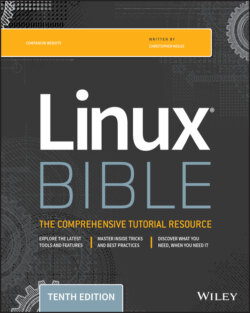Читать книгу Linux Bible - Christopher Negus - Страница 29
Linus builds the missing piece
ОглавлениеLinus Torvalds started work on Linux in 1991, while he was a student at the University of Helsinki, Finland. He wanted to create a UNIX-like kernel so that he could use the same kind of operating system on his home PC that he used at school. At the time, Linus was using Minix, but he wanted to go beyond what the Minix standards permitted.
As noted earlier, Linus announced the first public version of the Linux kernel to the comp.os.minix newsgroup on August 25, 1991, although Torvalds guesses that the first version didn't actually come out until mid-September of that year.
Although Torvalds stated that Linux was written for the 386 processor and probably wasn't portable, others persisted in encouraging (and contributing to) a more portable approach in the early versions of Linux. By October 5, 1991, Linux 0.02 was released with much of the original assembly code rewritten in the C programming language, which made it possible to start porting it to other machines.
The Linux kernel was the last—and the most important—piece of code that was needed to complete a whole UNIX-like operating system under the GPL. So when people started putting together distributions, the name Linux and not GNU is what stuck. Some distributions, such as Debian, however, refer to themselves as GNU/Linux distributions. (Not including GNU in the title or subtitle of a Linux operating system is also a matter of much public grumbling by some members of the GNU project. See https://gnu.org.)
Today, Linux can be described as an open source UNIX-like operating system that reflects a combination of SVID, POSIX, and BSD compliance. Linux continues to aim toward compliance with POSIX as well as with standards set by the owner of the UNIX trademark, The Open Group (https://opengroup.org).
The nonprofit Open Source Development Labs, renamed the Linux Foundation after merging with the Free Standards Group (https://linuxfoundation.org), which employs Linus Torvalds, manages the direction today of Linux development efforts. Its sponsors list is like a Who's Who of commercial Linux system and application vendors, including IBM, Red Hat, SUSE, Oracle, HP, Dell, Computer Associates, Intel, Cisco Systems, and hundreds of others. The Linux Foundation's primary charter is to protect and accelerate the growth of Linux by providing legal protection and software development standards for Linux developers.
Although much of the thrust of corporate Linux efforts is on enterprise computing, huge improvements are continuing in the desktop arena as well. The KDE and GNOME desktop environments continuously improve the Linux experience for casual users. Newer lightweight desktop environments such as Chrome OS, Xfce, and LXDE now offer efficient alternatives that today bring Linux to thousands of netbook owners.
Linus Torvalds continues to maintain and improve the Linux kernel.
